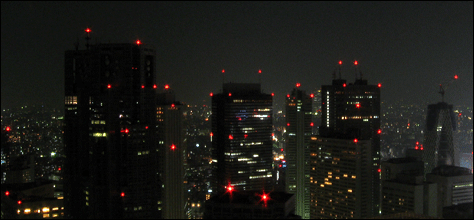 Waking up on Sunday, 16 March, I was excited to get out and exploring. Steven
Waking up on Sunday, 16 March, I was excited to get out and exploring. Steven  managed to get this day off from work, so he suggested some key places to visit and we were our way. Our destination was Harajuku Station
managed to get this day off from work, so he suggested some key places to visit and we were our way. Our destination was Harajuku Station  on the JR East
on the JR East  Yamanote Line
Yamanote Line  , the circle connecting most of the major stations in Tokyo
, the circle connecting most of the major stations in Tokyo  . Our schedule would give us a sampling of both old and new Tokyo, plus a few surprises along the way.
Located in the Shibuya
. Our schedule would give us a sampling of both old and new Tokyo, plus a few surprises along the way.
Located in the Shibuya  special ward of Tokyo, known for its large shopping and entertainment areas, the station was definitely busy. Emerging into the daylight at the Omotesando
special ward of Tokyo, known for its large shopping and entertainment areas, the station was definitely busy. Emerging into the daylight at the Omotesando  exit, we proceeded across the bridge over the rail lines south of the station toward Yoyogi Park
exit, we proceeded across the bridge over the rail lines south of the station toward Yoyogi Park  and the Meiji Shrine
and the Meiji Shrine  . Dedicated to Emperor Meiji
. Dedicated to Emperor Meiji  (1852–1912) and Empress Shoken
(1852–1912) and Empress Shoken  (1849–1914), the Shinto
(1849–1914), the Shinto  shrine was established in 1920 to honor their role in the Meiji Restoration
shrine was established in 1920 to honor their role in the Meiji Restoration  .
Walking under and past the Torii
.
Walking under and past the Torii  gate at the entrance to the complex into the wooded park area, the city fades behind you leaving a breeze of fresh, oxygenated air and the sights and sounds of nature. There are many visitors here but the spaciousness of the stone walkway allows uncrowded movement. After passing a display of wine* donated for consecration and artfully decorated sake barrels* whose full history remain locked in the Japanese-only sign*, we approached the main buildings. * links to images coming soon
As I took pictures waiting for Mom to purchase an omamori
gate at the entrance to the complex into the wooded park area, the city fades behind you leaving a breeze of fresh, oxygenated air and the sights and sounds of nature. There are many visitors here but the spaciousness of the stone walkway allows uncrowded movement. After passing a display of wine* donated for consecration and artfully decorated sake barrels* whose full history remain locked in the Japanese-only sign*, we approached the main buildings. * links to images coming soon
As I took pictures waiting for Mom to purchase an omamori  , I noticed a professional photographer setting up and taking portraits. The formally dressed subjects were an older man and woman seated in front with two young girls and a man in uniform standing behind. By now several other visitors had stopped to watch and take pictures, so it was quite a treat for everyone when suddenly a woman dressed in an all white, traditional wedding kimono
, I noticed a professional photographer setting up and taking portraits. The formally dressed subjects were an older man and woman seated in front with two young girls and a man in uniform standing behind. By now several other visitors had stopped to watch and take pictures, so it was quite a treat for everyone when suddenly a woman dressed in an all white, traditional wedding kimono  walks by escorted by two individuals. I would later see her in another part of the shrine having photographs taken.
walks by escorted by two individuals. I would later see her in another part of the shrine having photographs taken.
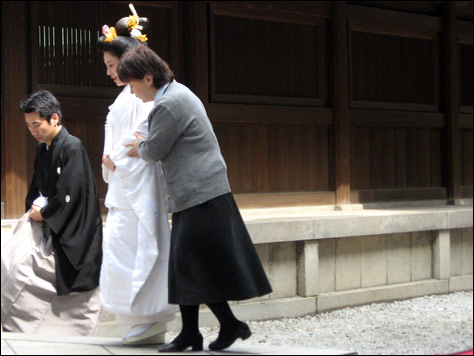 We next approached the Chozuya
We next approached the Chozuya  pavilion and Steven explained the purification ceremony for which it is used. Ablution complete, we proceeded to the main yard and shrine. Although destroyed by fire in 1945 from air raids, the present structures built in 1958 retain the feel of the original Nagerezukuri architecture. I particularly enjoyed the design and spent some time walking around and looking at things like shide
pavilion and Steven explained the purification ceremony for which it is used. Ablution complete, we proceeded to the main yard and shrine. Although destroyed by fire in 1945 from air raids, the present structures built in 1958 retain the feel of the original Nagerezukuri architecture. I particularly enjoyed the design and spent some time walking around and looking at things like shide  , omikuji
, omikuji  and ema
and ema  .
.
 Slowly we made our way back to the entrance for the second part of our visit in Harajuku
Slowly we made our way back to the entrance for the second part of our visit in Harajuku  . Steven said the area by the shrine entrance and station was a weekly meeting place of people whom kids in US high schools would pejoratively term "freaks." As we approached, you could see things had picked up even more since we arrived earlier. There were artists and street performers painting, singing and dancing. I stopped and watched a group of teenagers with signs advertising "free hugs" that were happy to hug any who approached. Quite a number of kids were wearing all sorts of crazy clothes and jewelry, some emulating the Lolita gothic and takenoko-zoku
. Steven said the area by the shrine entrance and station was a weekly meeting place of people whom kids in US high schools would pejoratively term "freaks." As we approached, you could see things had picked up even more since we arrived earlier. There were artists and street performers painting, singing and dancing. I stopped and watched a group of teenagers with signs advertising "free hugs" that were happy to hug any who approached. Quite a number of kids were wearing all sorts of crazy clothes and jewelry, some emulating the Lolita gothic and takenoko-zoku  styles. By far the most interesting person there was a man wearing a pink apron, pink stuffed animal and a pink tiara with bunny ears. He wanted nothing more than to wish us well and pose for a photo (that is his akomeogi
styles. By far the most interesting person there was a man wearing a pink apron, pink stuffed animal and a pink tiara with bunny ears. He wanted nothing more than to wish us well and pose for a photo (that is his akomeogi  I am holding).
I am holding).
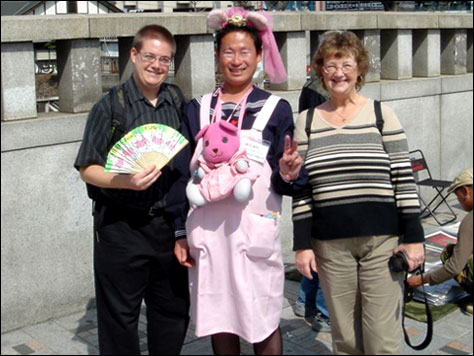 Continuing on north, we stopped at Snoopy Town
Continuing on north, we stopped at Snoopy Town  , an officially licensed Peanuts gift shop across the street from Harajuku Station. Peanuts, known as Snoopy in Japan, and the cartoon gang are apparently popular so this store had everything you could want with a character on it, like the World of Disney store in Orlando but not quite as large.
Mom purchased a gift for a friend and we proceeded to the pedestrian-only shop-lined Takeshita Street
, an officially licensed Peanuts gift shop across the street from Harajuku Station. Peanuts, known as Snoopy in Japan, and the cartoon gang are apparently popular so this store had everything you could want with a character on it, like the World of Disney store in Orlando but not quite as large.
Mom purchased a gift for a friend and we proceeded to the pedestrian-only shop-lined Takeshita Street  , followed by a stroll down the Omotesando avenue. While these areas normally attract many locals and visitors alike for the wide variety of shopping available, it was particularly busy this day for a reason that quickly became apparent. Green beer. Green T-shirts. Flags of Japan and Ireland side-by-side. No shit, we stumbled into the beginnings of the 17th St. Patrick's Day Parade Tokyo
, followed by a stroll down the Omotesando avenue. While these areas normally attract many locals and visitors alike for the wide variety of shopping available, it was particularly busy this day for a reason that quickly became apparent. Green beer. Green T-shirts. Flags of Japan and Ireland side-by-side. No shit, we stumbled into the beginnings of the 17th St. Patrick's Day Parade Tokyo 

 .
.
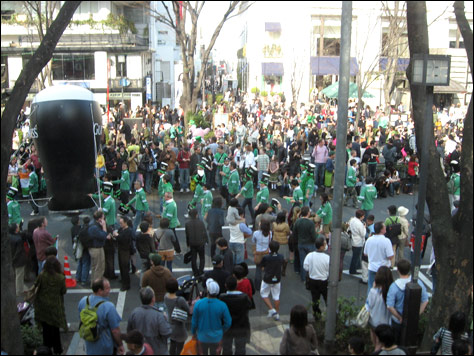 Since all I had consumed thus far was a bottle of water and a large can of Kirin
Since all I had consumed thus far was a bottle of water and a large can of Kirin  Sparkling Hop
Sparkling Hop  , we decided to stop and grab a bite at Shakey's Pizza
, we decided to stop and grab a bite at Shakey's Pizza  , the Californian pizza chain that now has more locations in Asia than in the US. After waiting for a table in the stairs leading up to the restaurant, we somehow managed to be seated at one of only four window booths. Were tipping a custom here, I would have slipped the host a bill for sure.
From this perfect location, I had the truly unique experience of eating Japanese pizza at Shakey's while watching a St. Patrick's Day parade go by on the street below. The restaurant was buffet-style, yet another detail I did not expect, but it worked out well for trying the various selections. They included tuna and onion, octopus, corn, shrimp mayonnaise, mayonnaise corn, potato bacon, beef and onion, cuttlefish and olive, anchovy and tomato, Japanese curry and of course, good ‘ole pepperoni. I really liked the corn, Japanese curry and octopus pizzas, but did not care for those with mayonnaise.
, the Californian pizza chain that now has more locations in Asia than in the US. After waiting for a table in the stairs leading up to the restaurant, we somehow managed to be seated at one of only four window booths. Were tipping a custom here, I would have slipped the host a bill for sure.
From this perfect location, I had the truly unique experience of eating Japanese pizza at Shakey's while watching a St. Patrick's Day parade go by on the street below. The restaurant was buffet-style, yet another detail I did not expect, but it worked out well for trying the various selections. They included tuna and onion, octopus, corn, shrimp mayonnaise, mayonnaise corn, potato bacon, beef and onion, cuttlefish and olive, anchovy and tomato, Japanese curry and of course, good ‘ole pepperoni. I really liked the corn, Japanese curry and octopus pizzas, but did not care for those with mayonnaise.
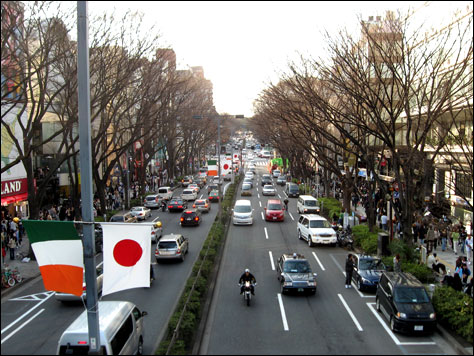 Fortunately, the parade ended during our meal so we were able to walk a less-crazy Omotesando, stopping in various stores like Oriental Bazaar
Fortunately, the parade ended during our meal so we were able to walk a less-crazy Omotesando, stopping in various stores like Oriental Bazaar  and Kiddy Land
and Kiddy Land  to browse and pick-up a few items. We finished around 1600 local and decided to head to our next destination before we lost daylight. Steven and I grabbed a beer at the Harajuku Station convenience store and we all got back onto the Yamanote Line, destination: Shinjuku Station
to browse and pick-up a few items. We finished around 1600 local and decided to head to our next destination before we lost daylight. Steven and I grabbed a beer at the Harajuku Station convenience store and we all got back onto the Yamanote Line, destination: Shinjuku Station  .
Before continuing, it seems like a good time to mention a few social behaviors that we observed. For example, eating and smoking on trains or while walking around is frowned upon and in many cases prohibited, but drinking including alcoholic beverages is acceptable. I took advantage of this frequently because, hey, I was on vacation and you can get delicious Japanese beer and canned cocktails everywhere.
Talking is rare but does occur on trains and lifts, but cellular telephone use, while seemingly more popular than in the US (i.e. everyone has and uses one constantly), is for the most part kept to SMS text messages while in public places. Signs inside subway cars state no telephone talking should take place and ringers are to be switched to vibrate or silent mode. Thinking back, I can recall only a few isolated instances where I heard ring tones at all during the trip. That was nice.
Smoking, as popular as it remains in Tokyo, is relegated to designated smoking areas that are clearly marked and always provide an ashtray. I noticed people adhere to the regulation and do not light up unless near one, despite their sometimes-infrequent locations. Most restaurants offer smoking and non-smoking sections, sometimes separated by floor, room or partition. Trains do not allow smoking, except in designated cars on the Shinkansen
.
Before continuing, it seems like a good time to mention a few social behaviors that we observed. For example, eating and smoking on trains or while walking around is frowned upon and in many cases prohibited, but drinking including alcoholic beverages is acceptable. I took advantage of this frequently because, hey, I was on vacation and you can get delicious Japanese beer and canned cocktails everywhere.
Talking is rare but does occur on trains and lifts, but cellular telephone use, while seemingly more popular than in the US (i.e. everyone has and uses one constantly), is for the most part kept to SMS text messages while in public places. Signs inside subway cars state no telephone talking should take place and ringers are to be switched to vibrate or silent mode. Thinking back, I can recall only a few isolated instances where I heard ring tones at all during the trip. That was nice.
Smoking, as popular as it remains in Tokyo, is relegated to designated smoking areas that are clearly marked and always provide an ashtray. I noticed people adhere to the regulation and do not light up unless near one, despite their sometimes-infrequent locations. Most restaurants offer smoking and non-smoking sections, sometimes separated by floor, room or partition. Trains do not allow smoking, except in designated cars on the Shinkansen  , and stations have smoking areas during certain hours only (one sign indicated a smoking prohibition during the morning commute rush hours).
As I mentioned before, the Yamanote Line is one of the busiest in Tokyo. While waiting on the platform for our train to Shinjuku
, and stations have smoking areas during certain hours only (one sign indicated a smoking prohibition during the morning commute rush hours).
As I mentioned before, the Yamanote Line is one of the busiest in Tokyo. While waiting on the platform for our train to Shinjuku  , I opened my beer and it foamed and spat a little. Steven laughed and mentioned a time where he saw that happen to someone while on a busy train. Talk about embarrassing. Needless to say, I was additionally cautious during the standing room-only ride to the busiest train station in the world (3.52 million people per day in 2006).
, I opened my beer and it foamed and spat a little. Steven laughed and mentioned a time where he saw that happen to someone while on a busy train. Talk about embarrassing. Needless to say, I was additionally cautious during the standing room-only ride to the busiest train station in the world (3.52 million people per day in 2006).
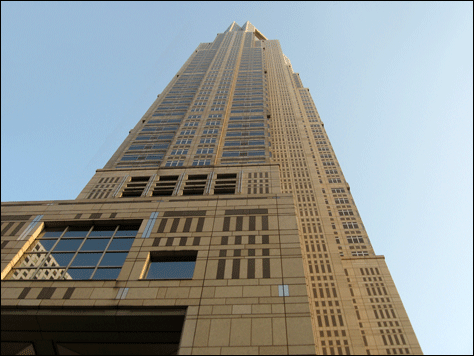 After navigating Shinjuku Station to the exit, we walked down the street beneath the many skyscrapers, some of which I saw the evening prior when Mom and I stopped to look around on our way back to the apartment. Looking up at the towers of the Tokyo Metropolitan Government Building
After navigating Shinjuku Station to the exit, we walked down the street beneath the many skyscrapers, some of which I saw the evening prior when Mom and I stopped to look around on our way back to the apartment. Looking up at the towers of the Tokyo Metropolitan Government Building  , I learned Steven's plan was to take us inside where you can ride up to a free observation deck on 48F (floors of buildings are labeled as such: B3F, B2F, B1F, 1F, 2F, 3F and so on). After a brief security sweep, we were on our way to the northern tower atop Building One.
Although part of the view was obscured by a restaurant, the windows available offered an excellent look at the Shinjuku skyscrapers and the city as a whole. Helpfully mounted at each window was a labeled picture identifying the major structures visible, an excellent tool for labeling my own pictures. As was the case the day prior, there was some haziness but you could still see buildings in more distant parts of the city. There were quite a few people up here taking pictures, so you had to wait or squeeze in to get vistas and photographs. Unfortunately, I had a difficult time preventing reflections but some images came out well.
, I learned Steven's plan was to take us inside where you can ride up to a free observation deck on 48F (floors of buildings are labeled as such: B3F, B2F, B1F, 1F, 2F, 3F and so on). After a brief security sweep, we were on our way to the northern tower atop Building One.
Although part of the view was obscured by a restaurant, the windows available offered an excellent look at the Shinjuku skyscrapers and the city as a whole. Helpfully mounted at each window was a labeled picture identifying the major structures visible, an excellent tool for labeling my own pictures. As was the case the day prior, there was some haziness but you could still see buildings in more distant parts of the city. There were quite a few people up here taking pictures, so you had to wait or squeeze in to get vistas and photographs. Unfortunately, I had a difficult time preventing reflections but some images came out well.
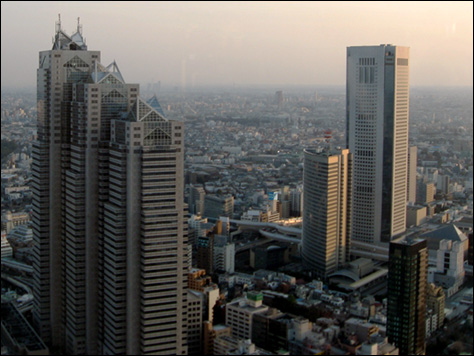 After watching a rather lackluster sunset from the observatory, we headed back downstairs and proceeded to walk to one of the buildings I just saw and photographed—although I did not realize it at the time. It was our next and final destination for our evening with Steven, the Shinjuku Park Tower
After watching a rather lackluster sunset from the observatory, we headed back downstairs and proceeded to walk to one of the buildings I just saw and photographed—although I did not realize it at the time. It was our next and final destination for our evening with Steven, the Shinjuku Park Tower  , home to retail stores (1F–7F), office space (8F–37F) and the Park Hyatt Tokyo
, home to retail stores (1F–7F), office space (8F–37F) and the Park Hyatt Tokyo  (39F–52F).
(39F–52F).
 It was 1900 local and dark when we entered the 1F lobby from the south side of the building. Walking through, we passed the banks of lifts designated for groups of floors eventually making our way, with the help of a building attendant, to the north entrance and the lifts to the hotel. As the lift doors closed in front of me, I anticipated and heard the ding-dong and swish audible in the 2003 film Lost In Translation
It was 1900 local and dark when we entered the 1F lobby from the south side of the building. Walking through, we passed the banks of lifts designated for groups of floors eventually making our way, with the help of a building attendant, to the north entrance and the lifts to the hotel. As the lift doors closed in front of me, I anticipated and heard the ding-dong and swish audible in the 2003 film Lost In Translation  . I love that sort of thing. I have previously stated I felt coming here was a cliché American thing to do, but my reason to do so was simple. If you have not guessed by now, I have a thing for tall buildings and the lights on them. The view offered by this building and the overall ambiance of enjoying a little luxury at 235 metres (771 feet) were all too compelling to pass up.
The doors opened at 41F dramatically revealing the Peaks Lounge
. I love that sort of thing. I have previously stated I felt coming here was a cliché American thing to do, but my reason to do so was simple. If you have not guessed by now, I have a thing for tall buildings and the lights on them. The view offered by this building and the overall ambiance of enjoying a little luxury at 235 metres (771 feet) were all too compelling to pass up.
The doors opened at 41F dramatically revealing the Peaks Lounge  atrium overlooking the city. We continued past the Girandole
atrium overlooking the city. We continued past the Girandole  restaurant, through the library and into the reception area that is more like a stylish bank branch with desks and chairs for guests to sit and check-in. From here, we took one last lift to 52F. What I said before about the doors opening dramatically is multiplied by ten when you arrive at 52F, the elevator ding-dong, door swish and all. You are greeted by a dimly lit reception area that consists of one small room, one large window, a friendly hostess and her podium. The view was incredible here but enjoying it more would have to wait, as the hostess was quickly ready to whisk us away to our table in the New York Bar
restaurant, through the library and into the reception area that is more like a stylish bank branch with desks and chairs for guests to sit and check-in. From here, we took one last lift to 52F. What I said before about the doors opening dramatically is multiplied by ten when you arrive at 52F, the elevator ding-dong, door swish and all. You are greeted by a dimly lit reception area that consists of one small room, one large window, a friendly hostess and her podium. The view was incredible here but enjoying it more would have to wait, as the hostess was quickly ready to whisk us away to our table in the New York Bar  .
.
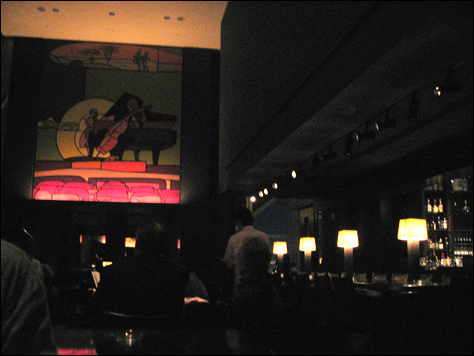 We were not important enough to get a window table, but we were next to one and it sat empty for the first half of our visit. The saxophone and piano male duet played some great jazz tunes while we looked over the unexpectedly large menu, ordered and clanked our glasses with kanpai
We were not important enough to get a window table, but we were next to one and it sat empty for the first half of our visit. The saxophone and piano male duet played some great jazz tunes while we looked over the unexpectedly large menu, ordered and clanked our glasses with kanpai  . I ordered a Suntory
. I ordered a Suntory  Whisky
Whisky  on the rocks a la Bill Murray
on the rocks a la Bill Murray  , which was met with some confusion by the waiter because they apparently had several choices. Since I had not seen them, the waiter turned the pages in my menu and pointed to a section where the only English word in the title was "Japanese." I guess their whiskey is really popular. I selected the one in the middle, costing around ¥2,000 JPY ($20 USD). We sat and enjoyed ourselves for an hour, making trips to an unoccupied seating area behind and below us from where we could take pictures at the window, and to the restroom, featuring the most technologically featured toilet I have ever seen.
, which was met with some confusion by the waiter because they apparently had several choices. Since I had not seen them, the waiter turned the pages in my menu and pointed to a section where the only English word in the title was "Japanese." I guess their whiskey is really popular. I selected the one in the middle, costing around ¥2,000 JPY ($20 USD). We sat and enjoyed ourselves for an hour, making trips to an unoccupied seating area behind and below us from where we could take pictures at the window, and to the restroom, featuring the most technologically featured toilet I have ever seen.
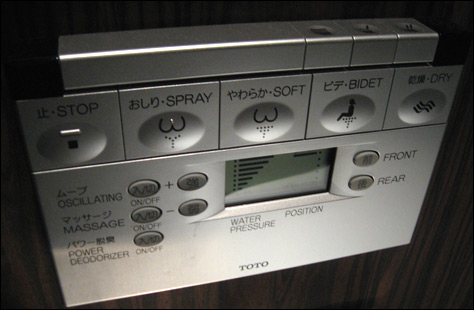 After paying our tab which included a 10% service charge and ¥2,000 JPY ($20 USD) per person cover charge, we started our trip back to the apartment, stopping in the building throughout to look around and take pictures. As we walked back toward Shinjuku Station, I thought that it was nice after three whiskeys not to have to worry about leaving my car somewhere and fetching an expensive taxi ride home. Once back, Steven and I ventured out again, stopping at various Three-F
After paying our tab which included a 10% service charge and ¥2,000 JPY ($20 USD) per person cover charge, we started our trip back to the apartment, stopping in the building throughout to look around and take pictures. As we walked back toward Shinjuku Station, I thought that it was nice after three whiskeys not to have to worry about leaving my car somewhere and fetching an expensive taxi ride home. Once back, Steven and I ventured out again, stopping at various Three-F  stores for food and drink while walking the neighborhood to chat and pick-up a package from the post office, offering a 24-hour counter. It was hard to believe another whole day (305 pictures) had passed, but I went to sleep well with anticipatory thoughts of the next.
stores for food and drink while walking the neighborhood to chat and pick-up a package from the post office, offering a 24-hour counter. It was hard to believe another whole day (305 pictures) had passed, but I went to sleep well with anticipatory thoughts of the next.
Mount Sutropresents The Japan Trip Series
[ Day One | Day Two | Day Three | Day Four | Day Five | Day Six ] Photograph Gallery
Photo Credit: David July 
Photo Credit: Steven Patten

Photo Credit: Steven Patten






